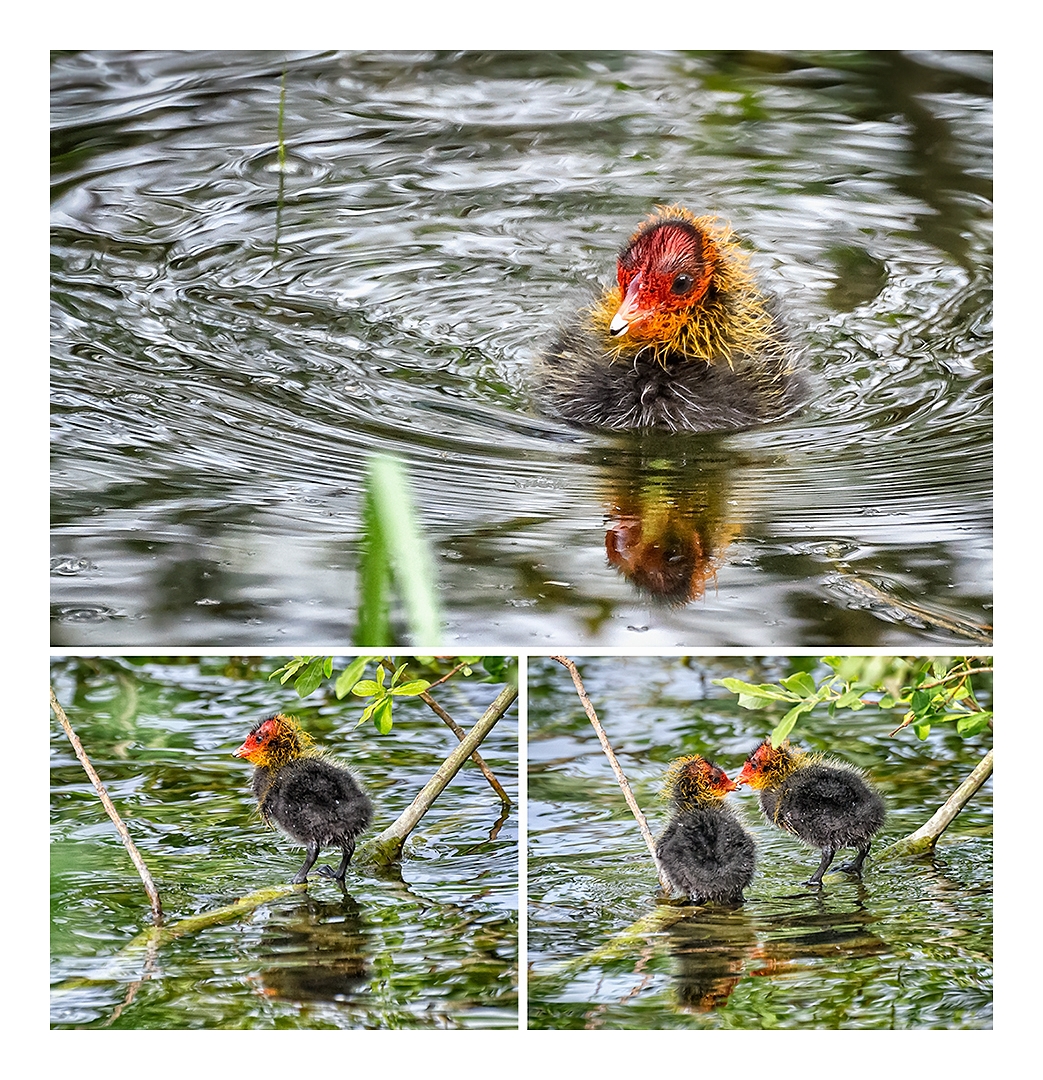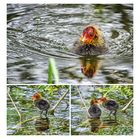Wo hat sich...
...mein Geschwisterchen versteckt?
Im Mai diesen Jahres konnte ich die kleinen Blässhuhnküken im Düsseldorfer Südpark während ihrer ersten Lebenswochen beobachten. Viespielt und immer hungrig, schwammen sie im Üfernähe mit ihrer Mutter umher. Wenn die Teichhuhnküken mit ihren bunten Köpfen die Punks unter den Rallen sind, so sind die Blässhuhnküken, mit ihren langen, zotteigen Haaren die Hippies unter denRallen. ;- )
"Das Gelege besteht aus 5–10 glanzlosen oder schwach glänzenden Eiern von etwa 53 × 36 mm Größe, die auf beigem bis hellgrauem Grund fein rotbraun bis schwarz gepunktet sind. Junge Blässhühner sind Nestflüchter, die bereits nach kurzer Zeit schwimmen können, die aber meist noch 2–4 Tage im Brutnest gehudert und gefüttert werden und noch etwa eine Woche dort schlafen. 4–5 Wochen werden die Jungen von den Eltern im Familienverband geführt und gefüttert. Dabei hält sich ein Teil der Jungen an den Vater, ein Teil an die Mutter. Diese kümmern sich jeweils nur um „ihren“ Teil. Von den Jungvögeln sterben im 1. Lebensjahr zwischen 75 und 87 Prozent, von den zweijährigen Vögeln erleben 48 bis 72 Prozent nicht das nächste Lebensjahr. Das älteste beringte Exemplar, das bislang gefunden wurde, ist ein in Dänemark aufgefundenes Individuum, das 20 Jahre und sieben Monate alt wurde."
Quelle: https://de.m.wikipedia.org/wiki/Blässhuhn
Where has ... ... hidden my sibling?
In May of this year, I was able to observe the little coot chicks in the Duesseldorf Southpark during their first weeks of life. Playful and always hungry, they swam around with their mother near the shore. When the moorhen chicks with their colorful heads are the punks under the rails, the coots are, with their long, shaggy hairs, the hippies under the rails. -)
"The clutch consists of 5-10 dull or slightly shiny eggs of about 53 × 36 mm in size, which are dotted on a beige to light gray ground, fine reddish brown to black. Peni coots are nesting breeders who can swim after a short time, but mostly stay 2-4 days in the nest and fed there for about a week. For 4-5 weeks, the chicks are led and fed by the parents of the family, where a part of the chicks tend to the father and part of them tend to the mother. Each of them only care about "their" part. Between 75 and 87 percent of the young birds die in their first year of life and 48 to 72 percent of the two-year-old birds do not live to see the next year. An individual found in Denmark who turned 20 years and seven months old."

















Oliver Schiebek 28/02/2021 22:23
Hübsch hässlich sind sie ja und die Collage dazu ist dir sehr gut gelungen!VG Oliver
† Ingeborg K 03/03/2019 15:18
Sehr schöne gelungene Fotos, gut zu einer Collage vereint.LG Ingeborg
noblog 15/12/2018 15:25
tolle EinzelbilderLG Norbert
hans-jakob 27/11/2018 18:33
Zauberhafte Portraits!!!LG hans-jakob
Gerd Frey 27/11/2018 10:52
die sin d imme rzum piepsen mit ihrem struwwelpeter-outfit.schöne szenen hast du da aufgenommen.
vg gerd
Markus 4 27/11/2018 8:55
mir gefällt immer wieder dieser fein herausgearbeitete Detailreichtum Deiner BilderSo auch hier, wo man jede Einzelheit des Gefieders erkennt
Habedieehre
Markus
Stefan Jo Fuchs 27/11/2018 7:10
hier spart sich die natur mal das Kindchenschema und lässt dennoch liebenswerte kleine Zottel auf die Welt los! ;-)lg stefan
Diruwi 27/11/2018 0:46
Die sind schon putzig!Aber irgendwann muss man sich losreißen ... :-))
Alles Gute, Dietmar
Vitória Castelo Santos 26/11/2018 22:32
Sie sind so süß :-)))LG Vitoria
Harold Thompson 26/11/2018 17:06
Good collage of the chicks exploring life:-)) Harold
Joachim Irelandeddie 26/11/2018 15:14
Die sehen ja zu niedlich aus! Eine sehr schöne Collage hast du hier von den kleinen Piepmätzen gemacht und dazu wieder sehr interessante Infos aufgeschrieben!lg eddie
LichtSchattenSucher 26/11/2018 14:06
Tolle Aufnahmen von den lustig und eigenwillig aussehenden Blaesshuhnjungen!Gruss
Roland
† Dieter Uhlig. 26/11/2018 13:46
ich bleibe dabei, die sehen häßlich aus :-}Richard Schult 26/11/2018 13:33
Auch diese Bilder: so typisch für Haltung und Verhalten.VG Richard